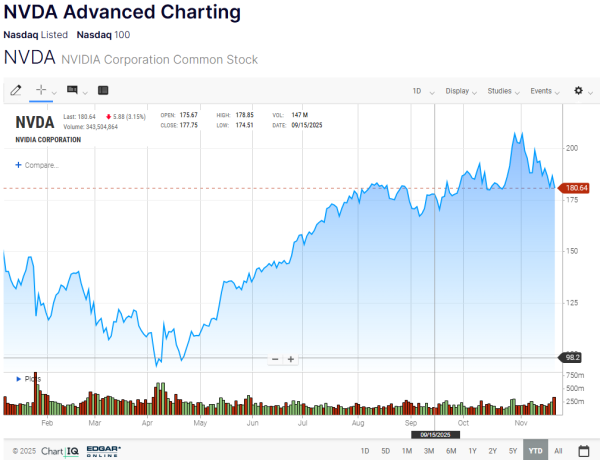The latest earnings from Nvidia arrived with the force of a market-moving catalyst, sending waves of renewed optimism across the AI investment landscape. What started as a strong surge in pre-market enthusiasm quickly transformed into a deeper conversation about sustainability, valuation, and long-term demand.
Brokers at Nexdi highlighted that Nvidia’s performance did more than simply beat expectations. It reaffirmed the company’s central role in the global AI buildout. With record revenue, explosive data center demand and CEO Jensen Huang’s confident dismissal of AI bubble fears, investors now face a critical question. Should they buy at these levels or remain cautious?
A Quarter That Redefined “Strong”: Nvidia’s Stunning Performance
Nvidia delivered one of the most impressive financial updates in modern tech history. Fiscal third-quarter revenue rose to 57 billion dollars, representing a 62% year-over-year surge and a 22% sequential increase. For a company already operating at a massive scale, acceleration of this magnitude is nearly unheard of.
The data center division, Nvidia’s crown jewel, was responsible for 51.2 billion dollars in revenue. This was a 66% increase from the prior year and a 25 % sequential jump, powered by insatiable demand for the company’s Blackwell GPU systems. Many brokers noted, these figures reinforce the notion that Nvidia is not simply benefiting from an AI trend but is functioning as the backbone supplier of the industry’s infrastructure.
Perhaps even more compelling was management’s forecast for the fourth quarter. Nvidia expects roughly 65 billion dollars in revenue, implying mid-teens quarter-to-quarter growth. For most companies, this would be a multi-year target. For Nvidia, it is the next step in a hypergrowth trajectory.
Huang’s Message to Investors: This Is Not a Speculative Bubble
During the earnings call, CEO Jensen Huang directly addressed a topic that has hovered over AI markets for months: the fear that the AI boom is fueled more by hype than substance. Huang stated, “There has been a lot of talk about an AI bubble. From our vantage point, we see something very different.”
He explained that the world is undergoing three platform shifts simultaneously. First is the industry-wide transition toward GPU-accelerated computing. Second is the rapid adoption of AI across enterprise applications. Third is the restructuring of data centers worldwide to support generative AI workloads.
Huang’s position is clear. He expects AI adoption to compound for years, not slow down. For investors concerned about overheating valuations, his comments offered reassurance that demand is structural rather than speculative.
A High-Quality Company With a High-Risk Valuation
Nvidia’s business fundamentals are among the strongest in the world, but the stock’s valuation requires careful consideration. Nvidia currently trades at roughly 46 times earnings, a premium multiple that reflects both its dominance and investor expectations for continued growth.
Such a valuation is defendable when revenue rises more than 60% and margins remain exceptionally strong. However, it also means Nvidia has minimal room to disappoint. Any slowdown in demand, delay in next-generation product rollout, or broad market volatility could result in sharper-than-normal price swings.
This is why brokers analyzing the stock noted that even though Nvidia represents one of the most attractive long-term opportunities in technology, prudent portfolio sizing remains essential. High valuation environments reward patience but can punish overexposure.
What This Means for Investors: Opportunity Meets Caution
For long-term investors, Nvidia’s business is undeniably compelling. The company continues to outpace rivals, drive technological innovation, and secure its position at the center of global AI acceleration. With strong guidance and record-breaking revenue now becoming a regular occurrence, the investment thesis remains firmly intact..
At the same time, Nvidia’s premium valuation and the market’s sensitivity to macroeconomic shifts introduce volatility that must be navigated carefully. Rising interest rates, shifts in GPU demand cycles, or geopolitical disruptions could all influence performance.
This is why many financial experts stress the importance of maintaining perspective. Nvidia may be a buy, but it should be approached with respect for market conditions and awareness of the risks tied to its valuation.
Final Verdict: A Leader Worth Owning, With Discipline
Nvidia remains one of the most powerful and profitable companies in the world. Its growth is accelerating, not slowing. Its CEO remains confident, not cautious. Its customers continue to expand their AI spending. And its latest quarter delivered some of the strongest numbers in tech history.
For investors, this makes Nvidia an appealing long-term holding. But the stock’s elevated valuation means positions should be built gradually and managed with discipline. Nvidia may still have significant upside ahead, but only for those who balance confidence with caution.









